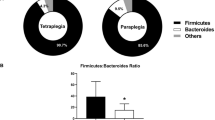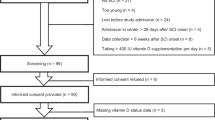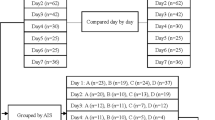Abstract
Study design: Spinal cord injury (SCI) patients with pressure sores were studied before and after surgical intervention for ulcer healing and compared with matched SCI patients without sores and with patients with pressure sores and other diseases.
Objective: To analyse the relationship between pressure sores and anaemia and serum protein alteration in SCI patients. To study the pathogenesis of these alterations and suggest appropriate therapy.
Setting: Spinal cord unit in Rome, Italy.
Subjects: A total of 13 SCI patients with pressure sores, 13 comparable patients without pressure sores and four patients with other diseases and pressure sores.
Main measures: Haematochemical parameters.
Results: Patients with pressure sore showed significant decreased red cells, decreased haemoglobin and haematocrit, increased white cells and ferritin and decreased transferrin and transferrin saturation; total hypoproteinemia and hypoalbuminemia with increased Alfa-1 and gamma globulins increased erythrocyte sedimentation rate and C-reactive protein were also present. The alterations returned to normal after surgical intervention for pressure sore healing.
Conclusions: Patients with pressure sores suffer from anaemia and serum protein alteration that fells within the range of metabolic alteration of chronic disorders and neoplastic diseases. The alterations depend on a decreased utilisation of iron stores in the reticuloendothelial system and on inhibition of the hepatic synthesis of albumin. With regard to treatment, iron treatment should be avoided because of the risk of haemochromatosis.
Similar content being viewed by others
Introduction
Pressure sores in spinal cord injury (SCI) patients are often accompanied by anaemia and hypoalbuminemia.1 These complications worsen prognosis and increase length of hospital stay.2 In a previous study, we demonstrated that patients with pressure sores often showed the coexistence of anaemia (with increased ferritin values and reduced transferrin), serum protein alteration (hypoalbuminemia with inverse albumin/globulin ratio, increased level of globulins and total hypoproteinemia) and inflammatory status (high erythrocyte sedimentation rate (ESR) and C-reactive protein (CRP) and white cell counts). We suggested that these alterations might be due to a chronic inflammatory status produced by the pressure sores and might be similar to chronic inflammatory diseases (such as rheumatoid arthritis) and tumours. We also demonstrated that all these alterations disappeared 30–60 days after spontaneous pressure sore healing.3
One criticism of our work was that SCI is a multifaceted disease that implies several metabolic changes, and that the alterations we found might not be related to the presence of pressure sores.
To investigate our previous hypothesis, we decided to evaluate several haematological parameters in a group of SCI patients with pressure sores before and after surgical intervention for sore healing, in a group of patients with other diseases and pressure sores, and in a group of SCI patients without pressure sores.
Patients and methods
A total of 13 consecutive SCI patients with pressure sores (males/females 11/2, mean age 47.5±12.4 years, mean distance from disease onset 4.2±4.1 months, mean pressure sore duration 3.7±3.9 months) were studied (group A). Ulcer severity was determined by the National Pressure Ulcer Advisory Panel (NPUAP) classification:4 all patients were diagnosed as having phase IV ulcers. At the time of examination, the ulcers were clean and did not show signs of severe infection. The mean decubitus area was 18.6±3.5 cm2. Neoplastic pathologies, chronic inflammatory and infectious diseases, collagenopathies, pre-existing anaemias and osteomyelitis were ruled out. Patients who received blood transfusions before and/or after surgical intervention were excluded. Patients underwent the following laboratory examinations: electroproteinogram, ESR, CRP, blood cell count with formula, serum iron, transferrinemia with per cent saturation and ferritinemia. The same examinations were repeated 15–20 days after surgical intervention.
Severity of anaemia was determined according to Lee et al's5 classification: mild anaemia (haemoglobin 9–11 g/dl), moderate anaemia (haemoglobin 7–8 g/dl), severe anaemia (haemoglobin <7 g/dl).
A small group of patients with other diseases (two multiple sclerosis, two stroke; males/females 2/2; mean age 53.3±6.4 years; mean disease duration 34.1±3.8 months; mean pressure sore duration 3.6±2.1 months; mean pressure sore area 19.1±4.5 cm2) was also examined (group B).
A control group of 13 SCI patients (matched one to one for age, sex distribution, distance from lesion and clinical features) without pressure sores was also examined (group C).
Statistical analysis was carried out by means of Student's t-test for dependent samples to examine the differences within group A patients and Student's t-test for independent samples to examine the differences between group A and group B and C patients. Decubitus ulcer area was correlated with degree of anaemia and serum protein alteration by means of Spearman's rank correlation coefficient (r). Differences were taken as significant if P<0.05.
Results
Dysmetabolic features
Compared to the control group, the patients with pressure sores showed anaemia with reduced serum iron, increased ferritin and reduced transferrin and transferrin saturation (Table 1).
They also had increased ESR and CRP, total hypoproteinemia, hypoalbuminemia, increased alfa-1 and gamma globulins and reduced albumin/globulin ratio (Table 1). No statistically significant correlation was found between serum protein alteration and decubitus ulcer areas (r=0.087).
All these metabolic alterations normalised soon after surgical intervention for pressure sore healing (Table 2).
Comparison with other groups
No significant difference emerged from the comparison between the two groups of patients with pressure sores; on the contrary, SCI patients without pressure sores showed a normal metabolic picture (Table 1).
Comparison before and after surgical intervention
When the data of pressure sore patients was compared after surgical intervention for pressure sore healing, rapid normalisation of all parameters was observed.
Discussion and conclusion
The results of the present study confirm our previous data and hypothesis.3 Patients with pressure sores show mild to moderate anaemia and specific serum protein alterations. More importantly, our work demonstrates that these metabolic alterations are closly related to the presence of sores and are not specific for SCI. Further, the same alterations were shared by SCI and non-SCI patients with pressure sores, but a comparable control group of patients without pressure sores did not show the same modifications. The disappearance of both anaemia and protein alterations soon after surgical healing of sores also supports our hypothesis.
With regard to aetiology, these alterations have the typical features of those resulting from chronic inflammatory disorders: hyporegenerative, normocytic, normochromic anaemia associated with reduced serum iron, reduced transferrin and transferrin saturation, but elevated ferritin;6 total hypoproteinemia with hypoalbuminemia, inverse albuminglobulin ratio, increased level of globulins; higher ESR and CRP and white cell counts.7 Chronic inflammatory status inhibits the use of iron stored in the reticuloendothetial system (RES)8, 9 and the hepatic synthesis of albumin.10, 11, 12, 13 The characteristics of anaemia and serum protein alteration, the coexistence of inflammatory status indexes, and the lack of correlation between metabolic alterations and pressure sore area do not permit us to attribute anaemia to a loss of plasma and blood from the sore or to protein hypercatabolism. If protein alterations are due to a loss of plasma from the decubitus or to accelerated protein catabolism, a decrease in all protein fractions should be expected. Finally, the anaemia of patients with pressure sores should be differentiated from iron-deficiency anaemia, which is characterised by reduced ferritin values and increased total transferrin.14
The aetiology is particularly important for choosing the correct treatment.
In our previous study,3 we suggested that anaemia and serum protein alteration tend to disappear with pressure sore healing. This hypothesis was criticised because of the long time needed for spontaneous healing; during this time other metabolic changes could take place that could explain our data. The present work demonstrates the close relationship between surgical healing of sores and metabolic improvement. Furthermore, it is our experience that both anaemia and serum protein alteration tend to decrease when the sores pass from the necrosis phase to the granulation phase and with the eradication of superimposed infections.
Serum protein alterations and anaemia rarely become so severe as to require blood or plasma transfusion. In our previous study, only five out of 40 patients required albumin administration because the hypoproteinemia caused diffused oedemas.3
With regard to anaemia therapy, patients with pressure sores are often treated with iron therapy;1, 15 since the anaemia of these patients is due to difficulty in using iron stores, iron treatment is useless, and might even be potentially dangerous because of the possibility of iatrogenic hemochromatosis.16 Recently, it has been demonstrated that the administration of erythropoiesis-stimulating proteins (erythropoietin and darbepoetin) may be effective in the treatment of this type of anaemia.17, 18
With regard to serum protein alteration treatment, some authors suggest administering albumin to patients to compensate for protein loss and help heal ulcers. Our data suggest that this form of treatment should be avoided. In fact, the main cause of hypoalbuminemia is not protein loss from the ulcer but reduced hepatic synthesis secondary to the chronic inflammatory state; furthermore, the efficacy of albumin administration to accelerate wound healing is debatable.19 The administration of albumin to treat dietary deficiencies is not advisable because of the lack of essential amino acids.20
Finally, we would like to underline the importance of surgery for improving SCI patients' rehabilitation. Although a period of partial rest from rehabilitation treatment is needed after surgery, early surgical healing of the sores allows patients to undergo further treatments (for example water therapy) and reduces their physical stress.
References
Perkash A, Brown M . Anemia in patients with traumatic spinal cord injury. J Am Paraplegia Soc 1986; 9: 10–152.
Burr RG, Clift-Peace L, Nuseibeh I . Haemoglobin and albumin as predictors of length of stay of spinal injured patients in a rehabilitation centre. Paraplegia 1993; 31: 473–478.
Fuoco U, Scivoletto G, Pace A, Vona VU, Castellano V . Anemia and serum protein alteration in patients with decubitus ulcer. Spinal Cord 1997; 35: 58–60.
National Pressure Ulcer Advisory Panel (NPUAP). Pressure ulcer prevalence, cost and risk assessment: Consensus development conference statement. Decubitus 1989; 2: 24–28.
Lee RG, Wintrobe MM, Bunn FH . Anemia sideropenica e le anemie sideroblastiche. In: Isselbacher KJ, Adams RD, Braunwald E, Petersdorf RG, Wilson JD (eds). ‘Harrison's Principi di medicina interna’ 1986, Vol. 2. Piccin: Padova, pp 2087–2091.
Bron D, Meuleman N, Mascaux C . Biological basis of anemia. Semin Oncol 2001; 28(2 Suppl 8): 1–6.
Hirsch GH, Menard MR, Anton HA . Anemia after traumatic spinal cord injury. Arch Phys Med Rehab 1991; 72: 195–201.
Bunn FH . Anemia associata a malattie sistemiche croniche. In: Isselbacher KJ, Adams RD, Braunwald E, Petersdorf RG, Wilson JD (eds). ‘Harrison's Principi di medicina interna’ 1986, Vol. 2. Piccin: Padova, pp 2109–2112.
Spivak JL . Iron and the anemia of chronic disease. Oncology (Huntingt) 2002; 16(9 Suppl 10): 25–33.
Jarnum S, Lassen NA . Albumin and transferrin metabolism in infections and toxic diseases. Scand J Clin Lab Invest 1961; 13: 357–361.
Sehgal PB . Interleukin-6: a regulator of plasma protein gene expression in hepatic and non-hepatic tissues. Mol Biol Med 1990; 7: 117–125.
Andus T, Bauer J, Gerok W . Effects of cytokines on the liver. Hepatology 1991; 13: 364–368.
Andus T, Holstege A . Cytokines and the liver in health and disease. Effects on liver metabolism and fibrogenesis. Acta Gastroenterol Belg 1994; 57: 236–244.
Wians FR, Urban JE, Keffer JH, Kroft SH . Discriminating between iron deficiency anemia and anemia of chronic disease using traditional indices of iron status vs transferrin receptor concentration. Am J Clin Pathol 2001; 116: 446–447.
Williams CM, Lines CM, McKay EC . Iron and zinc status in multiple sclerosis patients with bedsores. Eur J Clin Nutr 1988; 42: 321–328.
Corso F . Manuale di patologia clinica, 2nd edn. Masson: Milano, 1986, pp 75–88.
Turba RM, Lewis VI, Green D . Decubitus ulcer anemia: response to erythropoietin. Arch Phys Med Rehab 1992; 75: 498–500.
Kolesar JM . Novel approaches to anemia associated with cancer and chemotherapy. Am J Health Syst Pharm 2002; 59(15 Suppl 4): S8–S11.
Waldman TA, Gordon RS, Rosse W . Studies on the metabolism of serum protein and lipids in patients with analbuminemia. Am J Med 1984; 37: 960–968.
Mobarhan S . The role of albumin in nutritional support. J Am Coll Nutr 1988; 7: 445–452.
Author information
Authors and Affiliations
Rights and permissions
About this article
Cite this article
Scivoletto, G., Fuoco, U., Morganti, B. et al. Pressure sores and blood and serum dysmetabolism in spinal cord injury patients. Spinal Cord 42, 473–476 (2004). https://doi.org/10.1038/sj.sc.3101622
Published:
Issue Date:
DOI: https://doi.org/10.1038/sj.sc.3101622
Keywords
This article is cited by
-
Impact of complications at admission to rehabilitation on the functional status of patients with spinal cord lesion
Spinal Cord (2020)
-
Nutritional blood parameters and nutritional risk screening in patients with spinal cord injury and deep pressure ulcer—a retrospective chart analysis
Spinal Cord (2018)
-
Risk factors for pressure ulceration in a resource constrained spinal injury service
Spinal Cord (2011)
-
Anemia and hypoalbuminemia of chronic spinal cord injury: prevalence and prognostic significance
Spinal Cord (2010)
-
Traumatic and non-traumatic spinal cord-injured patients in Quebec, Canada. Part 2: biochemical profile
Spinal Cord (2010)



